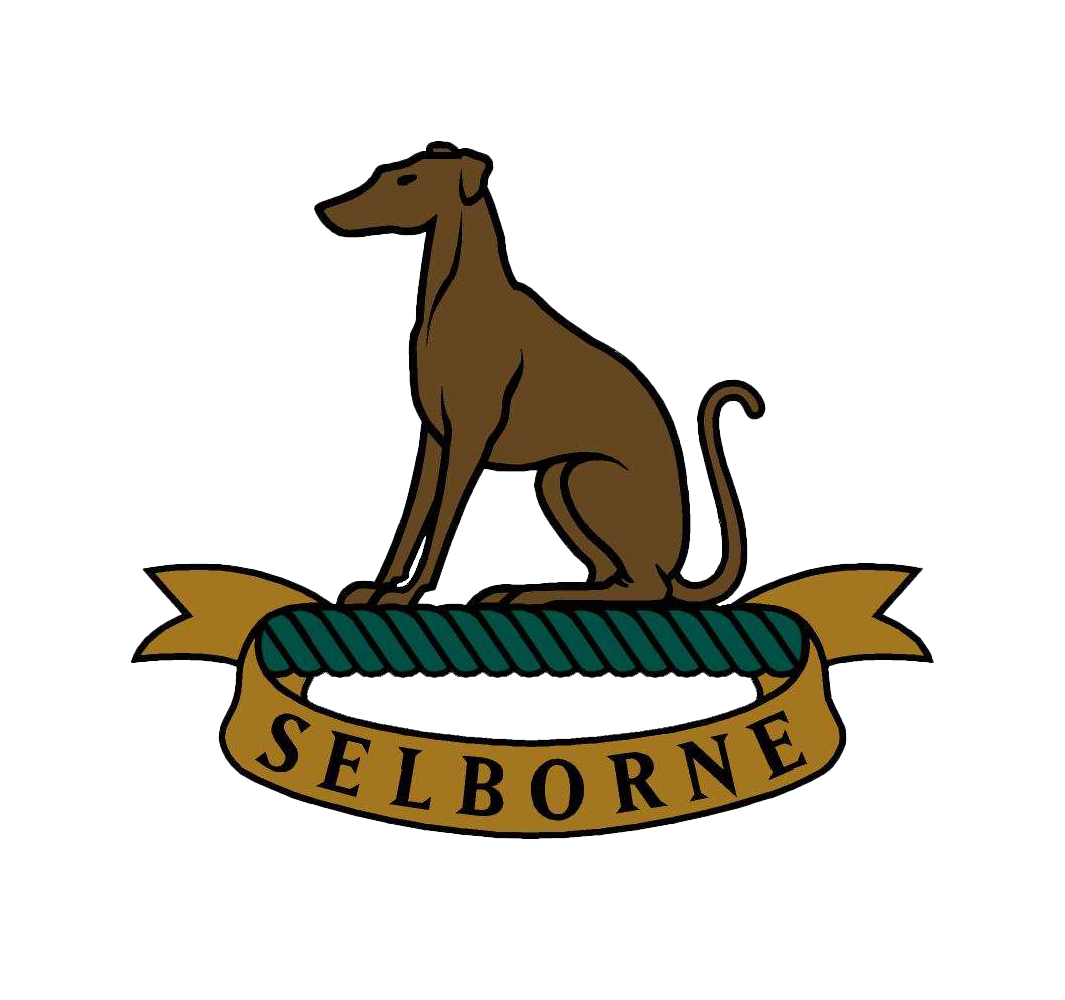In This Issue:
- Teeing Off: Welcome to the Weekly Tribune!
- Upcoming Events: May Golfing Events
- Pro Tips: Bunker Play
- Tournament Results: Competition Results
- Golf Rules & Handicapping: Rules / Course Knowledge Episode 3

1.Teeing Off: Welcome to the Weekly Tribune!
Welcome to yet another instalment of our Weekly Tribune! We extend our gratitude to all who dedicate their time to peruse our carefully crafted articles, designed to keep you informed and to aid with golf and its rules.
A friendly reminder to all Members who bring their own private carts onto the course: Remember to pay the trail fee at the shop on the day of play. If you’re using your cart, kindly inform the Proshop so they can adjust charges accordingly.
2. Upcoming Events! Events To Look Out For In May
We have array of events line up for you on the month of May. Here’s just to name a few!
Meat Hamper 9 Hole Competition – 3rd,10th, 17th, 24th and 31st May.
If you have yet to play in this day, you are missing out. Join us for 9 holes and compete to win one of 3 amazing meat hampers proudly sponsored by Blue Ocean Restaurant & Bar.
Shaun Parsons Memorial Trophy Event – 9th May
The format for the event is an Individual Stableford with great prizes up for grabs. There will also be nearest to the pins and snacks after prize giving for all competitors. Should you wish to join us for this special occasion, please contact the Proshop on 039 975 8500.
Halfway Toyota Sponsors Day – 30th May
Join us for an Alliance with a tasty difference. It’s a day of fun including a complimentary braai kindly sponsored by Halfway Toyota for all competitors after the round.
3. Pro Tips: Mastering Your Swing: Bunker Play
IMPROVE YOUR GAME WITH THESE EXPERT TIPS FROM THE PRO:
Ah, the dreaded bunkers of the golf course!
We’ve all had our fair share of encounters with these sandy pits of despair. It’s like stepping into a whole other dimension where confidence takes a nosedive and fear becomes your caddy.
But fear not, fellow golfer! With the wisdom I’m about to lay on you, you’ll be tackling those bunkers like a pro in no time.
Let’s talk about bounce, shall we?
Picture this: every club has its own bounce, which is like the superhero cape of the club head. It’s that curvy part below the leading edge that swoops in to save the day. Think of it as the club’s way of saying, “I got your back, buddy!”
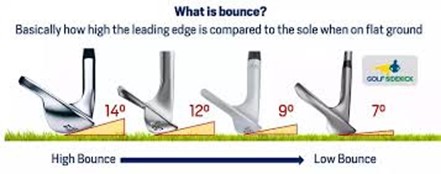
The bounce of the club acts a little like a hydrofoil in water – the curved shape helps “float” the clubhead through the sand preventing it digging too deeply and becoming trapped (as would be the case if a standard wedge were used).
The result of this is that the player can swing the club so it enters the sand behind the ball, sliding through the sand at a shallow depth to lift the ball from the bunker on a “cushion” of sand. The club and the ball never actually make contact – instead a handful of sand beneath the ball is lifted by the club which in turn lifts the ball.
How To Play A Bunker Shot
To gain more height the clubface should be opened before the hold is applied. This means that the clubface will initially be pointing to the right of the target. The club will still be hovering above the sand at this time.
Initially the shoulders are aligned parallel to the ball to target line with the feet slightly open to the ball to target line as in a Pitch shot.
Grip
The hold is taken in the normal way but only after the clubface has been opened. This means that the hold is in a weak position relative to the leading edge of the sand wedge. A key requirement of the grip for sand play therefore is to ensure that the club face remains open (to a greater or lesser degree) throughout the stroke.
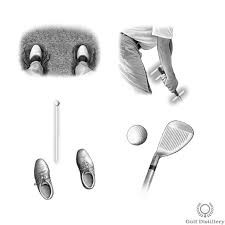
It is important that players do not merely open the club face by rotating the forearms at address as by the time the club reaches impact it will most likely have returned to a less open position than required.
Stance and Posture
When setting up to play the shot, a normal and stance width is maintained at just under shoulder width apart with 60-40 weight distribution favouring the left foot. A key issue in sand is to ensure a strong and stable base to support the swing. To achieve a firm footing, the player should work their feet into the sand to a depth that is usually slightly below the ball helping to ensure the clubhead passes below the ball at impact.
Ball Position
Ball position is Just forward of the middle of the stance. Generally speaking, the strike point in the sand remains the same as for a standard pitch i.e. in the middle of the stance – but the ball is now positioned forward of that strike point by some 2 inches
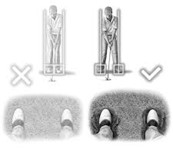
The Swing
The swing should be similar to that used when playing a pitch shot. During the downswing the club should be smoothly accelerating as it strikes the sand. Then the follow through should be at least the same length as the backswing, if not slightly longer due to the desire to smoothly accelerate through the sand.
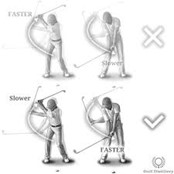
Distance Control
The same distance control procedures are to be used as with Pitching. It is easier to lengthen and shorten the stroke and maintain the amount of sand that is taken, than to try and take differing amounts of sand.
The single most effective way of building confidence (and proficiency) is successful experience. Therefore, lots of good practice is the ultimate way of developing good sand skills. So Get out there and get practicing .
4. Tournament Results: Competition Results!
Tournament Results: Players That Rose To The Top!
27th April – Fourball Alliance, 2 Scores To Count
1st: Zenzele Mzimela 84 Points
Zuko Baqwa
Muziwakhe Dlamini
Jimmy Ngcobo
3rd May – Individual Stableford (Sponsored By Blue Ocean Restaurant & Bar) 9 Holes
1st: Attie Hollenbach 20 Points
2nd: Tony Outram 18 Points
3rd: Gareth Parsons 16 Points oco

With a jaw-dropping jackpot of R25,500 up for grabs, the stakes have never been higher! For just a mere R10, you could secure your golden ticket to potential riches beyond your wildest dreams. But hurry, folks! With only 25 cards left in the deck, the clock is ticking, and Lady Luck is waiting to crown her champion. Join us this Saturday and dare to defy the odds. Will you be the one to claim the title of the chosen Joker?
5. Golf Rules & Handicapping: Make The Rules Work For You
Rules/Course Knowledge Episode 3
Penalty Areas
A penalty area is one of the five defined areas of the course and is any body of water on the course (whether or not marked by the Committee), including a sea, lake, pond, river, ditch, surface drainage ditch or other open watercourse (even if not containing water), and any other part of the course the Committee defines as a penalty area.
There are two different types of penalty areas, distinguished by the colour used to mark them:
- Yellow penalty areas (marked with yellow lines or yellow stakes) and gives the player two relief options (Rules 17.1d(1) and (2)).
- Red penalty areas (marked with red lines or red stakes) and gives the player an extra lateral relief option (Rule 17.1d(3)), in addition to the two relief options available for yellow penalty areas).
If the colour of a penalty area has not been marked or indicated by the Committee, it is treated as a red penalty area.
Selborne uses stakes to define the edges of penalty areas and therefore the edges are the lines between the outside points of the stakes at ground level (stake to stake), and the stakes are inside the penalty area. Stakes can be removed to play your shot but should be returned to exactly the same place.
Players may not realise that the edge of a penalty area extends both up above the ground and down below the ground which means that all ground and anything else (such as any natural or artificial object) inside the edge is part of the penalty area, whether on, above or below the surface of the ground.
If an object is both inside and outside the edge (such as a bridge over the penalty area, or a tree rooted inside the edge with branches extending outside the edge or vice versa), only the part of the object that is inside the edge is part of the penalty area.
If the Tournament Committee has mistakenly excluded an area of water that is clearly part of a penalty area when defining its edge (such as by placing stakes in a location that means there is a portion of water from the penalty area that appears to be in the general area), that area is part of the penalty area.
When the edge of a body of water is not defined by the Committee or stakes are missing, the edge of that penalty area is defined by its natural boundaries (that is, where the ground slopes down to form the depression that can hold the water).
Throughout the rules there is a concept called “known or virtually certain” and this means more than just possible or probable. It means that either:
- There is conclusive evidence that the event in question happened to the player’s ball, such as when the player or other witnesses saw it happen, or
- Although there is a very small degree of doubt, all reasonably available information shows that it is at least 95% likely that the event in question happened.
If it is not known or virtually certain that the ball came to rest in a penalty area and the ball is lost, the player must take stroke-and-distance relief (go back to where the player last played from – see Rules 18.1 and 14.6).
When Ball Is in Penalty Area
A ball found in a penalty area is in the penalty area when any part of the ball lies on or touches the ground or anything else (such as any natural or artificial object) inside the edge of the penalty area or is above the edge or any other part of the penalty area. If part of the ball is both in a penalty area and in another area of the course, see detail we covered in Episode 1.
If a player’s ball is in a penalty area, including when it is known or virtually certain to be in a penalty area even though not found, the player has these relief options, each for one penalty stroke:
- Stroke-and-Distance Relief. The player may play the original ball or another ball from where the previous stroke was made (see Rules 18.1 and 14.6).
- Take optional relief from the marked drop zones (Selborne only has drop zones on Hole 6 & 11 and these are only for where a ball entered a Red Penalty Area)
- Back-on-the-Line Relief. The player may drop the original ball or another ball (see
Rule 14.3) outside the penalty area, keeping the estimated point where the original ball last crossed the edge of the penalty area between the hole and the spot where the ball is dropped (with no limit as to how far back the ball may be dropped).
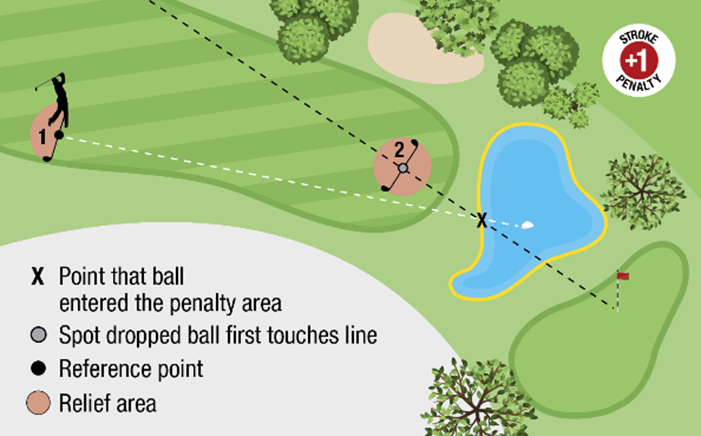
- Take lateral relief (red penalty area only). The reference point for taking relief is point X, and a ball must be dropped in and played from the two club-length relief area, which is no nearer the hole than point X.
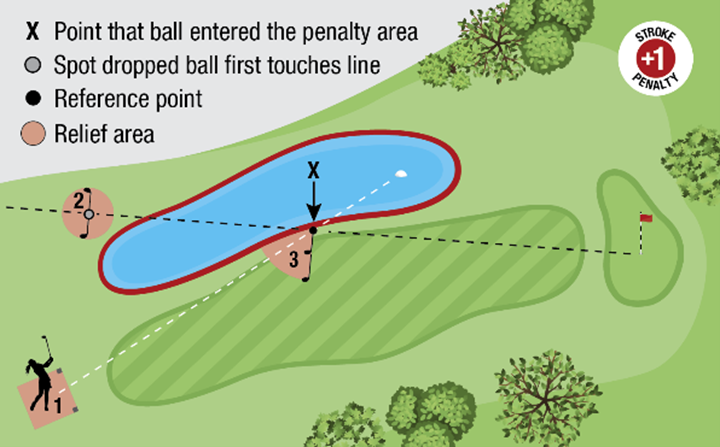
A player may stand in a penalty area to play a ball outside the penalty area, including after taking relief from the penalty area.
Once the player puts another ball in play to take relief in any of the above ways, the original ball is no longer in play and must not be played. This is true even if it is then found on the course before the end of the three-minute search time (see Rule 6.3b).
Reminders:
- If a player’s ball is known or virtually certain to have entered a penalty area, the player may not play a provisional ball.
- If a player’s ball clears the yellow penalty area on hole 15 but rolls back into the penalty area, part of the challenge of the hole is to carry over the yellow penalty area, therefore the player may not drop on the greenside part of the penalty area.
- If a ball is plugged in a penalty area, there is no free relief as the free relief is only available where a ball is plugged in the General Area.

